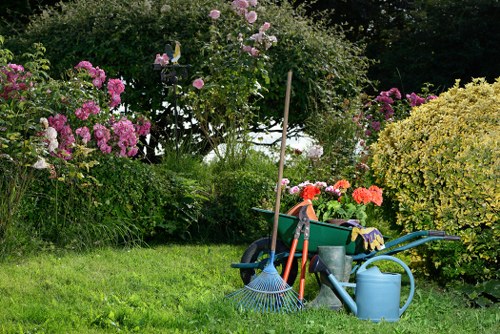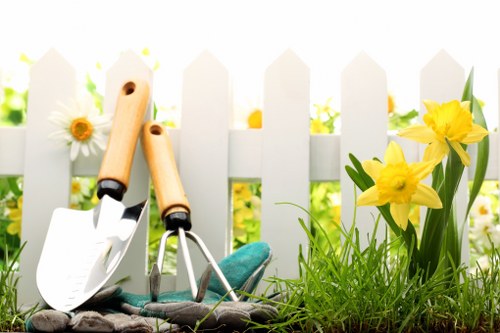Landscaping in Queens Park
The Beauty of Queens Park's Natural Landscape

Queens Park is renowned for its lush greenery, vibrant flora, and serene environment. Nestled in the heart of the city, it offers a picturesque setting that transforms throughout the seasons. Effective landscaping plays a crucial role in maintaining and enhancing this natural beauty, making Queens Park a prime location for both residents and visitors alike.
Implementing thoughtful landscaping designs can significantly improve the aesthetic appeal of any garden or outdoor space in Queens Park. Whether you have a spacious backyard or a modest balcony, the right combination of plants, structures, and decorative elements can create a stunning oasis that complements the natural surroundings.
Moreover, landscaping isn’t just about looks. It serves functional purposes such as providing shade, reducing noise pollution, and promoting biodiversity. In Queens Park, where urban and natural elements coexist, well-planned landscaping bridges the gap between city living and nature, offering a peaceful retreat for all.
Native Plants and Trees

One of the key aspects of successful landscaping in Queens Park is the use of native plants and trees. These species are well-adapted to the local climate and soil conditions, ensuring they thrive with minimal maintenance. Native flora not only enhances the beauty of your outdoor space but also supports local wildlife, contributing to the ecosystem's overall health.
Some popular native plants suitable for Queens Park include kangaroo paws, wattle trees, and
- Eucalyptus varieties
- Grevilleas
- Banksias
Incorporating native trees provides shade and structure to your garden. Species like the Queensland Cedar or Swamp Mahogany are excellent choices, offering both aesthetic and practical benefits. Their robust nature ensures longevity, making them a valuable investment for long-term landscaping projects.
Designing Your Landscape in Queens Park

Designing a landscape in Queens Park requires careful planning and consideration of various factors such as climate, soil type, and intended use of the space. A well-designed garden not only looks appealing but also caters to the functional needs of the homeowners.
Choosing the right plants is the first step in any landscaping project. Consider factors like sunlight exposure, water availability, and growth patterns. Mixing different plant types can create a layered effect, adding visual interest and diversity to your garden.
In addition to plants, incorporating hardscaping elements like pathways, patios, and water features can enhance the overall design. These structures provide structure and organization, making your outdoor space more usable and enjoyable.
Sustainable Landscaping Practices

Sustainability is a growing concern in modern landscaping. Implementing eco-friendly practices not only benefits the environment but can also reduce maintenance costs and improve the resilience of your garden against pests and diseases.
Some sustainable landscaping practices include using native plants, conserving water through efficient irrigation systems, and utilizing compost and organic fertilizers to enrich the soil. Additionally, incorporating composting areas and rainwater harvesting can further enhance the sustainability of your garden.
Emphasizing biodiversity by planting a variety of species can create a balanced ecosystem that naturally controls pests and supports beneficial insects and wildlife. This approach reduces the need for chemical pesticides, promoting a healthier and more vibrant landscape.
Professional Landscaping Services in Queens Park

While DIY landscaping can be rewarding, opting for professional landscaping services in Queens Park ensures a polished and expertly crafted outdoor space. Professionals bring expertise in design, plant selection, and maintenance, helping you achieve the desired look with ease.
- Design Services: Professionals can create customized landscape designs that align with your vision and the unique characteristics of your property.
- Plant Selection and Installation: Experts can recommend and install the best plants suited for your garden’s conditions, ensuring they thrive in the long term.
- Maintenance: Regular maintenance services, including pruning, fertilizing, and pest control, keep your garden healthy and beautiful throughout the year.
Hiring a landscaping service also saves you time and effort, allowing you to enjoy your outdoor space without the hassle of continuous upkeep. Whether you're looking to redesign your garden or simply maintain its current state, professional landscapers in Queens Park can provide the necessary support and expertise.
Benefits of Hiring Professionals

Professional landscapers have the knowledge and experience to handle diverse landscaping challenges. They can effectively manage soil quality, drainage issues, and plant health, ensuring your garden remains pristine and thriving.
Moreover, professionals stay updated with the latest trends and techniques in landscaping, offering innovative solutions that enhance the functionality and aesthetic appeal of your outdoor space.
Collaboration with a landscaping service also ensures the use of high-quality materials and sustainable practices, promoting the longevity and environmental friendliness of your garden. Investing in professional services is a smart choice for those seeking a hassle-free and beautiful landscape in Queens Park.
What to Expect from a Landscaping Service

When engaging a landscaping service in Queens Park, you can expect a comprehensive range of offerings tailored to your specific needs. From initial consultation to project completion, the process is designed to be seamless and efficient.
Services typically include:
- Consultation and Planning: Assessing your property and discussing your landscaping goals.
- Design Development: Creating detailed plans and selecting appropriate plants and materials.
- Installation: Implementing the design with precision and care.
- Ongoing Maintenance: Providing regular upkeep to maintain the garden’s health and appearance.
Clear communication and a collaborative approach ensure that the final result aligns with your expectations and enhances the overall appeal of your property.
DIY Landscaping Tips for Queens Park Residents

For those who prefer a hands-on approach, DIY landscaping in Queens Park can be both fulfilling and cost-effective. With proper planning and the right resources, you can create a beautiful and personalized outdoor space.
Here are some tips to get you started:
- Start Small: Begin with a manageable project, such as planting a flower bed or installing a garden path, and gradually take on more complex tasks.
- Research: Understand the specific needs of the plants you choose, including sunlight, water, and soil requirements.
- Tools and Equipment: Invest in essential gardening tools to make the process easier and more efficient.
By taking a methodical approach and steadily expanding your landscaping efforts, you can achieve a garden that reflects your personal style and meets your functional needs.
Planning Your Garden Layout

A well-thought-out garden layout is the foundation of successful landscaping. Consider factors such as the shape of your outdoor space, existing natural features, and the areas where you want to create focal points.
Use design principles like balance, symmetry, and proportion to guide the arrangement of plants and structures. Incorporating pathways, seating areas, and decorative elements can enhance the flow and usability of your garden.
Sketching a rough layout before starting can help visualize the final outcome and ensure all elements work harmoniously together.
Maintenance and Care

Regular maintenance is essential to keep your garden healthy and visually appealing. This includes tasks such as watering, weeding, pruning, and fertilizing. Establish a maintenance schedule to stay on top of these tasks and prevent issues from escalating.
Proper care not only promotes plant health but also extends the lifespan of your landscaping features. Investing time in maintenance ensures that your garden remains a source of pride and relaxation for years to come.
Additionally, staying informed about gardening best practices and being proactive in addressing problems can enhance the overall success of your DIY landscaping efforts.
Seasonal Landscaping in Queens Park

Queens Park experiences distinct seasons, each bringing unique opportunities and challenges for landscaping. Adjusting your gardening practices to align with seasonal changes ensures your outdoor space remains vibrant and resilient throughout the year.
Understanding the specific needs of your garden during each season allows you to plan effectively and maintain the health and beauty of your landscape.
The following sections outline the key considerations for each season in Queens Park:
Spring: Planting and Renewal

Spring is an ideal time for planting new plants and rejuvenating your garden. The warmer weather and increased rainfall promote healthy growth, making it perfect for establishing new flora.
Consider planting annuals and perennials that bloom in spring, adding color and life to your garden. Mulching can help retain moisture and suppress weeds, while preparing the soil ensures a strong foundation for new plants.
Pruning shrubs and trees during spring encourages new growth and maintains the desired shape and size of your plants.
Summer: Maintenance and Enjoyment

Summer brings warmer temperatures and extended daylight hours, providing ample time for garden maintenance and outdoor activities. Regular watering is vital to keep plants hydrated, especially during dry spells.
Implementing effective irrigation systems, such as drip irrigation or soaker hoses, can help conserve water and ensure even distribution. Additionally, mowing lawns regularly and removing spent blooms keeps your garden looking tidy and vibrant.
Creating shaded areas and incorporating water features can enhance the comfort and enjoyment of your outdoor space during the hot summer months.
Autumn: Preparing for Winter

As temperatures begin to drop, autumn is the time to prepare your garden for the winter months. This involves cleaning up fallen leaves, removing dead plants, and protecting sensitive species from frost.
Planting spring bulbs, such as tulips and daffodils, ensures a colorful display in the following season. Mulching garden beds helps insulate plant roots and retain soil moisture, safeguarding against cold weather.
Pruning trees and shrubs before winter reduces the risk of damage from snow and ice, maintaining the health and structure of your landscape.
Winter: Protecting Your Landscape

Winter poses challenges such as frost, snow, and reduced sunlight, requiring specific measures to protect your garden. Covering plants with frost cloths or burlap shields prevents damage from freezing temperatures.
Clearing pathways of snow and ice ensures safe access to your outdoor space. Additionally, maintaining a layer of mulch around plant bases helps preserve soil warmth and moisture during the cold months.
While some plants may remain dormant, providing appropriate care ensures they emerge healthy and ready to thrive when spring arrives.
Enhancing Your Landscape with Decorative Elements

Adding decorative elements to your landscape can elevate the overall aesthetic and create a more inviting atmosphere. Features such as sculptures, benches, and garden lighting contribute to the visual appeal and functionality of your outdoor space.
Incorporate hardscape elements like stone pathways, pergolas, or arbors to add structure and interest to your garden. These features not only serve decorative purposes but also provide practical benefits, such as defining walking areas and offering shade.
Garden lighting enhances the beauty of your landscape after dark, highlighting key features and creating a warm, welcoming ambiance for evening gatherings.
Water Features

Water features, such as fountains, ponds, or waterfalls, introduce a soothing element to your garden. The sound of flowing water can create a tranquil environment, while aquatic plants and wildlife add diversity to the ecosystem.
When designing a water feature, consider factors like size, location, and maintenance requirements. Proper installation and upkeep ensure the longevity and functionality of water elements in your landscape.
Alternatively, simple elements like birdbaths or small decorative ponds can achieve similar effects with minimal effort and investment.
Outdoor Furniture and Structures

Comfortable outdoor furniture and structures provide functional spaces for relaxation and entertainment. Seating areas, dining sets, and hammocks allow you to enjoy your garden comfortably, while pergolas and gazebos offer shaded retreats.
Select furniture that complements your landscape design and withstands the local climate. Durable materials like treated wood, metal, and weather-resistant wicker ensure longevity and minimal maintenance.
Strategically placing furniture and structures enhances the usability of your outdoor space, making it a pleasant environment for gatherings and personal relaxation.
Irrigation and Water Management

Effective irrigation and water management are essential components of successful landscaping in Queens Park. Ensuring your plants receive adequate water without wastage promotes healthy growth and environmental sustainability.
Implementing efficient irrigation systems, such as drip irrigation or sprinkler systems, ensures precise water delivery directly to plant roots. These systems minimize evaporation and runoff, conserving water and reducing utility costs.
Additionally, incorporating rainwater harvesting systems can capture and store rainwater for garden use, further enhancing water conservation efforts.
Drip Irrigation Systems

Drip irrigation systems provide water directly to the base of each plant, reducing waste and promoting deep root growth. These systems are particularly effective for garden beds, shrubs, and trees, ensuring they receive consistent moisture levels.
Installing drip irrigation involves laying out a network of tubing and emitters that deliver water at a controlled rate. This method not only conserves water but also minimizes the risk of overwatering and related plant diseases.
Automatic timers can be integrated with drip irrigation systems, allowing for scheduled watering that aligns with your garden’s specific needs and local climate conditions.
Rainwater Harvesting

Rainwater harvesting involves collecting and storing rainwater for later use in your garden. This sustainable practice reduces reliance on municipal water supplies and lowers your water bills.
Installing rain barrels or larger storage tanks can capture runoff from your roof, diverting it to your garden during dry periods. Proper filtration systems ensure the collected water remains clean and safe for plant use.
Combining rainwater harvesting with efficient irrigation practices creates a resilient water management system, enhancing the sustainability of your landscaping efforts.
Choosing the Right Landscaping Materials

Selecting appropriate landscaping materials is vital for the durability and aesthetic appeal of your outdoor space. From paving stones to mulch, the materials you choose impact both the functionality and visual harmony of your garden.
Consider the climate and environmental conditions in Queens Park when selecting materials. Opting for high-quality, weather-resistant options ensures longevity and reduces the need for frequent replacements.
Integrating a mix of natural and synthetic materials can create a balanced and inviting landscape. Stone pathways, wooden structures, and gravel beddings add texture and interest, while providing practical benefits like durability and ease of maintenance.
Pathways and Patios

Pathways and patios define movement and gathering areas within your garden. Materials like natural stone, concrete pavers, or gravel create functional and visually appealing surfaces that enhance the overall design.
Designing pathways to guide visitors through your garden highlights key features and promotes exploration. Patios serve as central hubs for outdoor activities, providing a space for dining, lounging, and socializing.
Choosing materials that complement your landscape design ensures a cohesive and harmonious outdoor environment.
Mulch and Ground Cover

Mulch and ground cover materials play a significant role in maintaining soil health and moisture levels in your garden. Organic mulches, such as wood chips or bark, enrich the soil as they decompose, while also suppressing weeds and reducing evaporation.
Inorganic options like gravel or pebbles provide low-maintenance ground cover that enhances the appearance of garden beds and pathways. Selecting the right type of mulch based on your garden’s needs ensures both functionality and aesthetic appeal.
Regularly replenishing mulch helps maintain its effectiveness, contributing to the long-term health and beauty of your landscape.
Conclusion

Landscaping in Queens Park offers endless opportunities to create a beautiful, functional, and sustainable outdoor space. Whether you choose to hire professionals or embark on a DIY journey, thoughtful design and maintenance are key to achieving a thriving garden.
By incorporating native plants, sustainable practices, and decorative elements, you can enhance the natural beauty of your surroundings while promoting environmental stewardship. Embrace the art of landscaping in Queens Park and transform your outdoor space into a personalized sanctuary that brings joy and tranquility year-round.
Contact us today to explore how you can elevate your landscape in Queens Park or book your service now and start your journey towards a stunning garden.